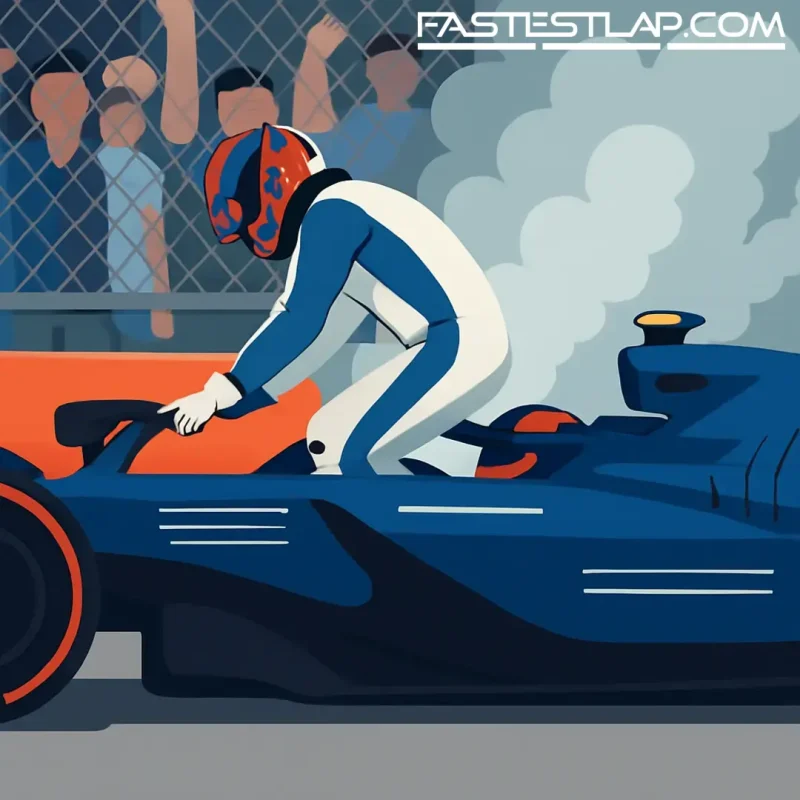Late VSC kills Mexico City thriller as Sainz’s stadium spin forces Race Control’s hand
The Foro Sol was primed for a grandstand finish. Instead, the boards lit up “VSC,” the noise dipped, and what should’ve been a two-lap slugfest fizzled out under control.
Carlos Sainz’s late spin in the stadium section triggered a Virtual Safety Car and, with it, a chorus of groans from the stands. The Williams driver lit the rears on the exit of the right-hander after the tight left in the complex, looped the car, tagged the wall with the right-rear and broke the suspension. He crab-walked to an opening, nosed the car behind the barrier—but crucially, the rear remained exposed to the track.
Onboard footage made the situation look borderline: front axle tucked, rear still on the racing surface. From trackside, it was clearer. Marshals were on their feet and heading into the runoff to deal with the stricken car. Once that happens, Race Control’s options shrink to one. You neutralize.
The timing made it brutal. Max Verstappen had hunted down Charles Leclerc and was shaping a last-lap lunge for second place. Oscar Piastri had closed on Oliver Bearman for fourth and was inside DRS. These weren’t just petty squabbles for line position. Piastri’s fourth place would’ve been worth more than bragging rights; it would’ve preserved a points cushion at the sharp end of the championship. Verstappen, meanwhile, needed every inch and every point with four rounds left after Mexico City.
Instead, both were locked into formation for the run home. No dive-bombs in Turn 1, no toe-to-toe braking into the stadium, just delta targets and a slow walk to the flag.
Cue the backlash. From the seats, it felt heavy-handed: low-speed corner, two racing laps to go, car largely tucked away. Let them race, right? But from the FIA perch, the calculation is different. Safety isn’t situational. If marshals are on or near a live track, the race gets neutralized—even more so after recent criticism over trackside risk management. A near-miss for Liam Lawson earlier in the afternoon only sharpened Race Control’s resolve.
Here’s the hard truth. Whether it’s Lap 5 or Lap 70, one standard applies. Neutralize the risk, then worry about everything else. And while it’s easy to grumble about timing—and yes, the timing was horrible—the moment Sainz’s Williams stopped with its rear still in harm’s way, the decision was effectively made. Once officials stepped through the opening, the VSC became non-negotiable.
That doesn’t make it any less deflating. The Mexico City Grand Prix had been winding up nicely. Verstappen had pace in hand and the scent of a podium climb. Leclerc was playing defense with trademark poise. Piastri was measuring Bearman, battery and brakes at the ready. The stadium was bouncing. Then, blink, neutralized.
If you’re looking for a villain, aim higher than the Race Director. This is the consequence of a more conservative philosophy that’s taken root in recent seasons, a deliberate swing toward caution after years of criticism any time marshals or drivers found themselves exposed. The mandate is clear: safety obligations trump sporting theatre. You can dislike the outcome without pretending the process was wrong.
Was the car “safe enough” where it stopped? From certain angles, maybe. From the one that matters—the one balancing human beings on foot against one-ton projectiles—the answer was no. And that’s the only angle Race Control is allowed to use.
Still, from a sporting perspective, it stung. It robbed us of a crescendo the race had earned. Verstappen vs. Leclerc for silver, Piastri vs. Bearman for heavyweight points in a title fight that’s been razor-thin—these are the moments you mark in bold. Mexico got the ellipsis instead.
Sainz, for his part, will want a quiet flight home. The lap was innocuous right up to the bite of the kerb, then it wasn’t. A tiny misjudgment in the slowest part of the track snowballed into the biggest call of the afternoon.
In the end, this is one of those days where two truths can exist at once. The Virtual Safety Car was the correct call. And it was a rotten way to finish an otherwise compelling Grand Prix. That tension is baked into modern Formula 1. We ask for spectacle, we get a safety-first sport. Most of the time, the two coexist. Sometimes, as Mexico just proved, they collide.
The championship picture will move on to the next round with a little more mystery than it should’ve had. Maybe that’s fitting. Titles are shaped by lunges and laps, but also by split-second decisions in a control room and a car parked six inches the wrong side of a fence.




